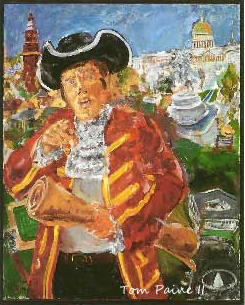Besides pointing to the hoard of $1 coins that Fed banks have failed to circulate, the only evidence that the Fed paper cites in support of its killer "strong preference" finding is a single 2008 poll. The Fed paper fails to mention any of three more recent polls posted prominently on the DCA website, conducted by Ramussen (61% in favor), The Washington Post (62% in favor), and The Terrance Group with Hart Research Associates (65% in favor). These polls differed from the poll cited by the Fed, in that they provided respondents with the GAO's savings estimates; and they would surely have been even more favorable, had the dramatically higher correct savings been provided.
Given that it touts deference to the public will as ultimately controlling, the Fed paper is rendered frivolous by its failure to report these polls. The Fed paper's claim to present objective research is a fraud, for it nowhere cites a July 2013 paper by ex-Treasury official Aaron Kline, TIME FOR CHANGE: Modernizing To The Dollar Coin Saves Taxpayers Millions, sponsored by the DCA and Citizens Against Government Waste, [7] despite lifting a number ($109 million [8]) from page 12, favoring its own case. The same page summarizes the adverse survey results.
Ex-Mint Director Philip Diehl's 2012 testimony describes how in the early 2000s, strong initial public demand for new $1 coins "ultimately flagged," because "[f]or many years, the dollar coin has faced another significant obstacle: the [Fed's] preference for the dollar note." He explained that the Fed banks, having resisted distributing the new coin, had then contrived to squelch a highly successful campaign to directly distribute it through Walmart stores, which it did by jumping on board so as to soak up and sit on the available supply.
According to the 2013 GAO report Coin Inventory Management Needs Better Performance Information
Federal Reserve officials noted the $1 note is an alternative to the $1 coin that the public freely chooses--that is, their view is that the $1 coin is fully available to the public and its circulation is thus at the level that the public demands. According to Federal Reserve officials, the Federal Reserve's authority does not extend to promotion, and therefore the agency is not likely to take unilateral action to promote wider circulation of the $1 coin.
The Fed clothes itself in the flag of neutral deference to the will of the people. In reality, the Fed paper is just the last in a long series of deceptive barriers erected against the people's $1 coin.
3. TakeawaysRe the benefits of replacing the $1 bill with a $1 coin, an updated GAO report is overdue, together with a wide new public survey. These should incorporate not only a game-changing increase of seigniorage benefits, but descriptions of the highly unhygienic nature of $1 notes.
To meet reasonable objections as to bulk, the GAO and the public should also consider the option of eliminating the penny in concert with the introduction of a similarly-sized but snazzy new $1 coin series. Even if private conversion costs were fully subsidized, the switch would cost many billions less than nothing, in light of the roughly $12 billion savings that would accrue during the changeover.
But the greatest benefit would not be modernization of the nation's cash, or the ongoing multi-billion dollar gain. The greatest benefit would be teaching the public the true value of its $1 coin, creating cognition enough to make "the monetary sovereignty of the United States" a meaningful phrase.
Stay tuned.
[1] Recently, concerns have been raised re conversion costs imposed on private business and re the hygiene of paper money. See Dirty Dollars on the DCA website.
[2] See How The One Dollar Coin Can Cure The Economy and Ninth Circuit Leaves Door Open To Suit Against GAO Re Coins Act .
[3] The GAO's fallacy is sort-of-a-bit-like assuming someone will start holding ten times as many dollar bills on account of a windfall increasing her bank balance tenfold.
[4] Write info|AT|dollarcoinalliance.org info|AT|dollarcoinalliance.orgEmail address. DCA members comprise gaming and mineral interests, plus a couple of anti-government(-waste) groups, bamboozled by seigniorage. Some need to face the fact that pure but unsimple seigniorage is the prime part of the savings they seek, far more so than functional efficiencies. Monetary reform groups don't get why I bother with the puny $1 denomination, as though it were not the very unit of account.
[5] A few coin-savvy congressmen understand that coins generate seigniorage revenue at face value, and include such revenue estimates on the face of authorizing bills. For example, most face-value seigniorage is apparently (details aren't given) included in revenue estimates re the circulating State Quarters Program, set forth in H.R. 2535, the American Liberty Coinage and Deficit Reduction Act, introduced June, 2013. But the GAO's $1 coin-for-note swap estimates are obfuscated. To figure out what was and wasn't counted I had to read GAO reports back to 1990.
[6] See, e.g., Dollar Coins: Pathway to Patriotism or Branding Tool? and Susan B. Anthony, green M&Ms no laughing matter.
[7] Dueling Estimates. No-one (except me) appears to have seriously challenged the GAO estimates until this DCA paper attacked them as too high. It did so primarily on the ground that the GAO's assumed "replacement ratio" (per retired $1 bill, the average number of coins that the public chooses to hold) of 1.5:1, rather than 2:1. See pages 11-12. Only secondarily did the DCA paper reassess the relative cost and durability assumptions. The opposing Fed paper reassessed relative costs and durabilities, mostly based on technological updates, and proposed adding private conversion costs to the mix. All accepted the GAO formula for estimating seigniorage--the one item I dispute. Neither paper sought financial corrections of the order of magnitude that I seek.
(Note: You can view every article as one long page if you sign up as an Advocate Member, or higher).





